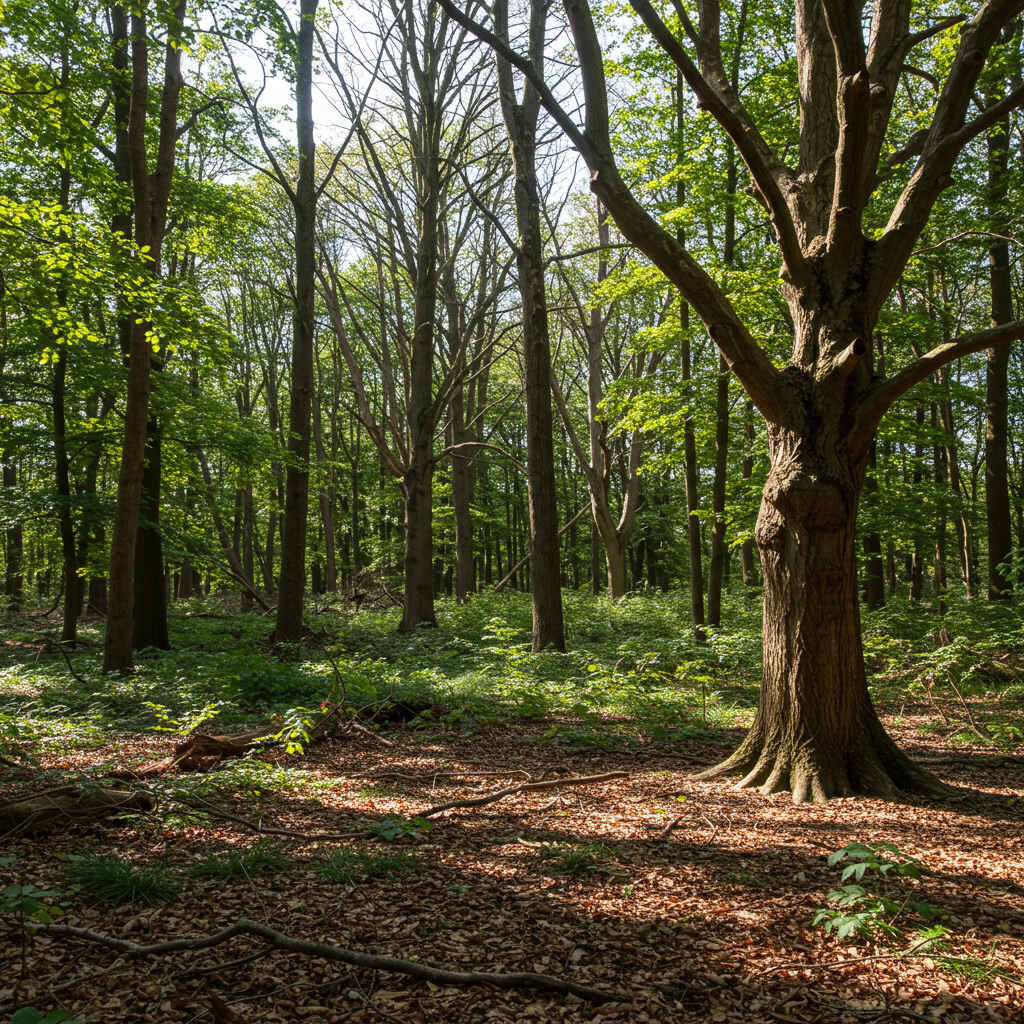British woodlands have faced a formidable enemy in recent years: ash dieback. This relentless fungal disease, caused by Hymenoscyphus fraxineus, has swept across the nation, casting a long shadow over the future of Britain’s beloved ash trees. Since its arrival in 2012, the disease has caused widespread devastation, leading to grim predictions about the potential loss of up to 85% of ash trees. However, amidst the tragedy, a new scientific revelation offers a crucial glimmer of hope.
Fresh research suggests that some British ash trees are not merely succumbing to the infection. Instead, they are beginning a fightback, naturally evolving greater resistance to the pathogen. This discovery shifts the narrative from one of potential extinction to one of cautious optimism, hinting that ash trees may yet remain a vital part of the UK landscape, albeit through a challenging evolutionary journey.
The Devastating Impact of Ash Dieback
Ash dieback’s impact on the British countryside has been profound. The fungus attacks ash trees of all ages, leading to withered leaves, lesions on stems and branches, and ultimately, often killing the tree. It has spread rapidly to every corner of the British Isles, affecting not just individual trees but entire woodlands and the diverse ecosystems they support.
Initial forecasts were stark, warning of mass tree mortality. While the situation remains critical, with millions of trees already lost and billions of seedlings at risk, the latest Europe-wide data suggests a potential loss closer to 50% over the next three decades, rather than the earlier 95% prediction in some regions. This revised outlook, though still severe, hints at the possibility of some trees possessing inherent resilience. The disease is now a harsh reality, considered by many experts to be a permanent feature of the landscape.
A Glimmer of Hope: The Discovery of natural Resistance
The most significant recent development is the scientific evidence demonstrating that natural selection is actively working within Britain’s ash population. This isn’t just theoretical; it’s being observed at the genetic level.
The Surrey Study: Witnessing Evolution in Action
A key study conducted by scientists from the Royal Botanic Gardens, Kew, and Queen Mary University of London focused on ash trees in Marden Park wood in Surrey. By comparing ash trees established before and after the fungus arrived in 2012, researchers identified subtle yet significant shifts in the genetic makeup of the younger generation. These trees, which grew up under the pressure of the disease, showed increased resistance compared to their predecessors.
How Evolution is Happening
This enhanced resistance isn’t due to a single ‘immunity’ gene. The research revealed that thousands of different genes contribute to an ash tree’s ability to fight off the fungus. Natural selection is favouring those trees that happen to possess a combination of DNA variants across these many genes that make them slightly more tolerant or resistant to the disease. As susceptible trees die off, the surviving, more resistant individuals are left to reproduce, passing their advantageous genetics onto the next generation.
Professor Richard Nichols described this as a “revelation for scientists,” acknowledging the difficult circumstances that allowed this discovery. The widespread death caused by the disease created a powerful selective pressure, and the sheer abundance of ash seedlings provided ample opportunity for natural selection to operate on a complex trait like disease resistance.
Why This is Significant
Discovering genetic evolution occurring in response to an environmental threat like ash dieback is hugely significant. It provides compelling, real-world evidence of Darwinian natural selection happening rapidly in nature, acting on a quantitative trait (disease resistance) influenced by numerous genes. This is something widely predicted but rarely proven so conclusively at the DNA level until now.
This finding offers a stark contrast to the fate of the elm tree, largely decimated by Dutch elm disease, which struggled to evolve resistance effectively. The scale of ash seedling production gives this species a better chance. While the hope is “borne out of the death of a lot of trees,” as Professor Richard Buggs noted, it fundamentally changes the long-term outlook for British ash.
Beyond Natural Selection: Human Intervention is Key
While natural evolution offers hope, scientists caution that it may not be enough on its own to fully secure the future of the species. Several factors could limit the rate of natural selection, including the existing genetic variation within the population and the potential for the selection process to slow as tree numbers decline. Therefore, active human intervention remains crucial.
Protecting Existing Trees
One vital intervention is protecting young, potentially tolerant ash trees from other threats. Grazing deer, for instance, can severely damage saplings, preventing those with genetic advantages from maturing and reproducing. Supporting natural regeneration means creating environments where these young trees can thrive and contribute to the evolving gene pool. Experts advise against felling infected ash trees unless they pose a safety risk, precisely because leaving tolerant trees standing allows them to set seed and produce offspring with better chances of survival.
Breeding the Resilient
Parallel to natural selection, selective breeding programmes are working to accelerate the process. The government-funded Living Ash Project identifies ash trees that show notable tolerance despite exposure to the fungus. These ‘super-ashes’ are then propagated in a National Archive of Tolerant Ash. The aim is to breed genetically diverse, disease-tolerant trees for future planting schemes. This is a slow process, but identifying the genetic markers associated with resistance is a critical step forward.
Exploring Novel Solutions
Scientists are also exploring innovative methods rooted in microbiology. Research is uncovering the role of the ash tree’s microbiome – the complex community of bacteria and fungi living within its tissues – in disease tolerance. Specific microbes have been associated with healthier trees. Furthermore, studies are looking at viruses that specifically infect the Hymenoscyphus fraxineus fungus itself, effectively weakening the pathogen.
Experimental inoculation of seedlings with beneficial bacteria has shown promise in reducing disease severity. While scaling these microbiome-based solutions presents challenges, and ensuring the use of native microbes is essential to avoid unintended ecological consequences, these discoveries offer exciting potential as future biological control agents, complementing evolutionary processes and breeding efforts.
The Broader Landscape: Ash Dieback and Ecosystem Resilience
The potential loss of ash trees isn’t just an arboricultural issue; it has significant ecological repercussions. Ash is a cornerstone species in British woodlands, supporting over 1,000 other species, including insects, fungi, and lichens. Its role as a fast-growing pioneer species is also vital for woodland succession. A significant decline in ash populations impacts the entire ecosystem.
Impact on Biodiversity
The devastation caused by ash dieback underscores how damaging introduced pathogens can be for native trees and the dependent species. Rebecca Gosling of the Woodland Trust highlights this, emphasizing the need to support natural regeneration to maintain biodiversity and better manage remaining ash populations.
Dead Trees Still Matter
Even dead and dying ash trees provide crucial ecological value. They become essential habitats for a variety of insects and fungi and contribute nutrients back into the soil, supporting the wider woodland ecosystem, which has historically been depleted by intensive timber harvesting. Management strategies must balance safety concerns with the ecological benefits of leaving standing deadwood where possible.
Facing Future Threats
Ash dieback serves as a stark “wake-up call” regarding the increasing threats to trees from climate change, which weakens tree defences and brings more erratic weather, and the arrival of new pests and pathogens. The potential arrival of the emerald ash borer beetle, already devastating ash trees in North America, represents a potential devastating “double threat” for British ash. Proactive surveillance, like the citizen science Observatree project and advanced techniques used by Forest Research, is crucial to detecting and responding to new threats early.
A Shift in Perspective
Ash dieback remains a severe threat to British trees and woodlands. The landscape has been irreversibly changed. However, the latest scientific findings, particularly the concrete evidence of natural selection and the advancements in breeding and microbial research, provide a new perspective. They replace the initial despair with a degree of cautious optimism and outline clear avenues for intervention. By supporting natural regeneration, continuing selective breeding, exploring novel biological controls, and enhancing surveillance against future threats, there is genuine hope that Britain’s cherished ash trees can fight back and, over time, evolve greater resilience, ensuring their place in the landscape for generations to come.
Frequently Asked Questions
What is ash dieback and why is it so devastating for UK trees?
Ash dieback is a serious fungal disease caused by Hymenoscyphus fraxineus, originating in Asia. It arrived in the UK around 2012 and spreads via fungal spores carried on the wind. The disease causes leaf wilting, branch lesions, and eventually kills the tree by blocking its water transport systems. It has been devastating because British ash trees had little natural resistance to the fungus, leading to widespread mortality across the country.
How are scientists helping ash trees fight ash dieback?
Scientists are assisting ash trees through several methods: researching natural resistance by identifying genetic traits in surviving trees that help them tolerate the disease; selective breeding programmes, like the Living Ash Project, to propagate these naturally tolerant trees; and exploring novel biological controls, such as studying the tree’s microbiome for protective microbes and investigating viruses that infect the dieback fungus itself.
What should happen to ash trees affected by ash dieback?
The recommended approach for ash trees affected by dieback depends on their location and condition. Trees posing a safety risk, especially near roads or public areas, should be assessed by a professional and potentially felled. However, for trees in woodlands or less-used areas, experts often advise leaving them standing. This allows any potentially tolerant trees to survive and reproduce, contributing to natural resistance evolution, and provides crucial habitat for wildlife even after the tree dies.
Word Count Check: 1140 words




